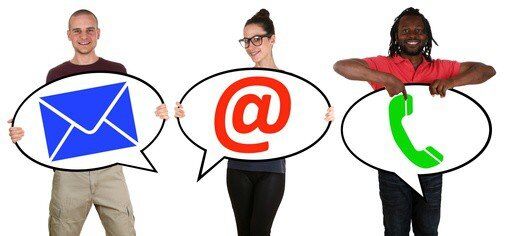
Back in the “olden days” you were limited with the choices you had for communication. You could talk to people face-to-face, you could write to them, or you could call them on the telephone. But then along came the office fax machine in the early 1970s, providing almost instant written communication – an alternative to a letter. Email was in its infancy and largely only used in the technology and academic sectors. It was around 20 years after the rise of the popularity of the fax machine before email started to become more mainstream.
Now, we have everything we had before – face-to-face, phone, fax and email – but we also now have SMS text messaging, instant messaging services, Twitter, Facebook, LinkedIn, live chat, Skype and Snapchat amongst many other alternatives. We have gone from having three ways we could communicate, to dozens.
That is a problem for the sender of the communication as well as the recipient. We now have to manage and try to sync together a whole array of communications. It means that we miss things, and some messages fall down between the gaps of our communication systems. It also means that senders of messages now have to multiply their work, sending out similar messages on a variety of communications systems, just to make sure that no-one misses what they are saying. That alone is adding hours of rather unproductive effort to the working day.
Choose the right tool for the job
Because of all the complications, people appear to be choosing a communications method to match a specific purpose. For instance, some people only use email for marketing communications, while choosing SMS text messages to keep in touch with family, and Facebook to communicate with friends. This categorisation appeals to the cognitive aspect of our brains which constantly seeks to provide order from the chaos of information surrounding us.
For businesses sending out all kinds of communication, it means that nowadays it is really important to find out the preferred route that people want to get the kind of material you send. For instance, the same customer may wish to get your marketing messages through email, but your advice and support through Facebook, whilst getting your tips and hints from Twitter. They will only notice your communications if these fit with what people focus their attention on within each system.
Recent research suggests that businesses are struggling with the rise in communications technology. The study found that people often felt “uncomfortable” using certain communications tools in particular circumstances. However, that fails to take into account the view of the recipient, who may be using a particular communications tool for a specific purpose.
For example, there are three psychological benefits of texting, which show that taken from a recipient’s perspective, businesses could be using SMS texts in more circumstances for greater effect.
Meanwhile the Indian entrepreneur, Pradeep Lokhande, has shown that by using postcards, instead of email, when you choose the right tool, you get significant results.
One of the problems for business productivity these days is that people are choosing to use every communication method for the same message, to make sure their audiences see what they are sending out. However, it may be more worthwhile to target specific kinds of communication using specific methods that match the expectations of the audiences.

